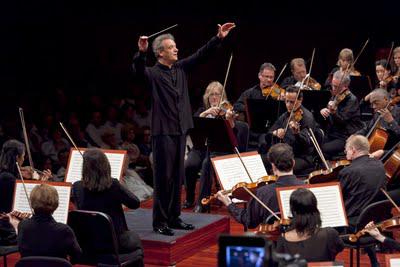Mostly Mozart ends with unfinished music.

The Mostly Mozart Festival Orchestra, led by conductor Louis Langrée.
Image courtesy Lincoln Center © 2010 Mostly Mozart/Lincoln Center.
The 2011 Mostly Mozart festival came to a premature end on Friday night. Due to the imminent arrival of Hurricane Irene this weekend, Saturday night's concert was cancelled. With the audiences from both nights combined at the last minute, a capacity crowd was on hand to hear the Mostly Mozart Festival Orchestra offer a program of Stravinsky, Schubert, and Mozart's last work, the Requiem. Louis Langrée conducted.
The packed house meant some unusual seating arrangements. My seat was on the stage, in one of the jury-box like arrangements that recall Wieland Wagner's 1961 production of Tannhäuser. Also, I could sight-read the double bass part over the musicians' shoulders during the Schubert "Unfinished" Symphony. For the Mozart Requiem I divided my attention between the choristers, the sheet music and conductor Louis Lortie.
The concert opened with Stravinsky's In Memoriam Dylan Thomas, a dirge-like setting of the poet's "Do Not Go Gently Into That Good Night." The work has an unusual chamber orchestration: four string players and four trombones. Tenor Joseph Kaisersang the complex vocal part (which belongs to Stravinsky's difficult, late style with fervent emotion and beauty of tone. As Hurricane Irene whirled slowly toward the city, the poem seemed an appropriate message for the assembled audience.
Schubert's Unfinished Symphony (his Eighth) remains a giant question mark in his career. Unlike Bruckner and Mahler (who also left incomplete symphonies) Schubert lived for several years after stopping work on this piece after only two movements. Those movements were played with sure beauty by the Festival Orchestra, coloring in the complicated woodwind parts and the rolling, eloquent main theme in the 'cellos. The second movement loped with easy grace, and the horns played with firm, ringing tone.
A great deal of myth swirls around Mozart's Requiem. Here's the truth: the work was commissioned by an eccentric nobleman: Count Franz Walsegg-Stupach who planned to pass it off as his own work.Mozart died having only completed the first movement. But he wrote out vocal sketches for the work up to the beginning of the Lacrimosa, the final section of the Dies Irae.. His widow Constanze hired composer Franz Xavier Süssmayer to finish the piece and meet the commission.
Unlike later Requiem masses by Berlioz and Verdi, Mozart eschews clock-you-on-the-head orchestration, relying on the power of the human voice to convey the message of the Latin text. This is most apparent in the Tuba mirum, where the Last Trumpet is announced by a ringing bass voice with brass accompaniment. Morris Robinson delivered this unearthly message with power and warmth. Soprano Julia Lezhneva, in her American debut, was impressive in the work's lyric passages, as was mezzo Kelley O'Connor.
The second half of the Requiem was written by Süssmayer. Strong choral contributions from the Concert Chorale of New York were prominent here, particularly in the Sanctus and Agnus Dei. The final passages of the work sound forth in a triumphal shout, quoting the very beginning of the mass. This might not be the most imaginative ending, but one can only imagine how Mozart would have done it.

